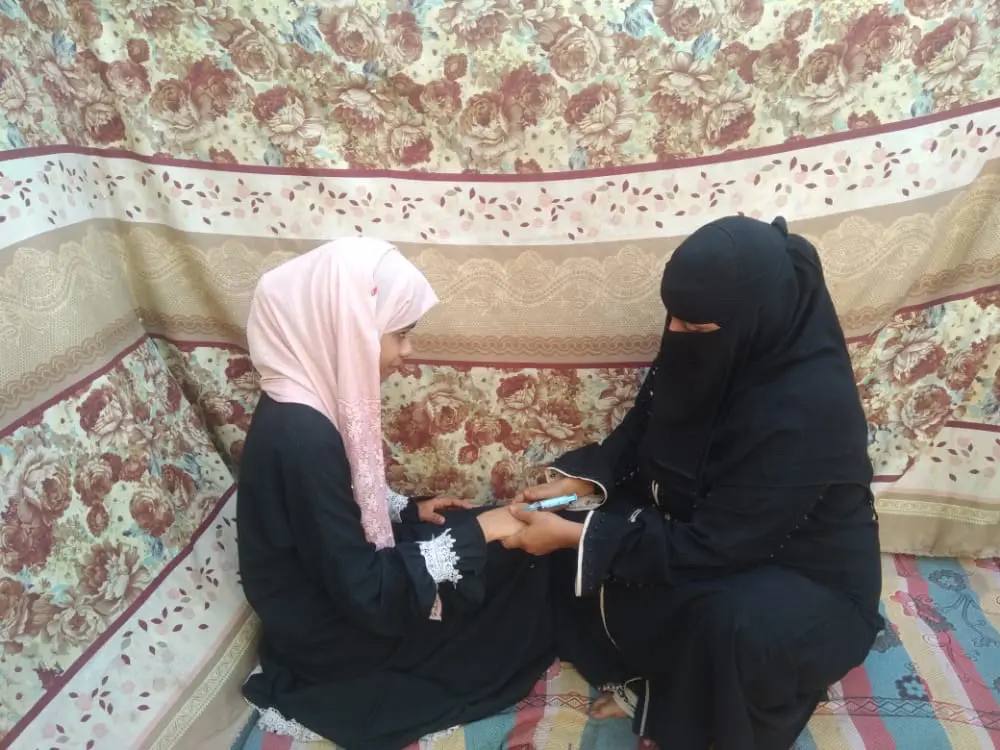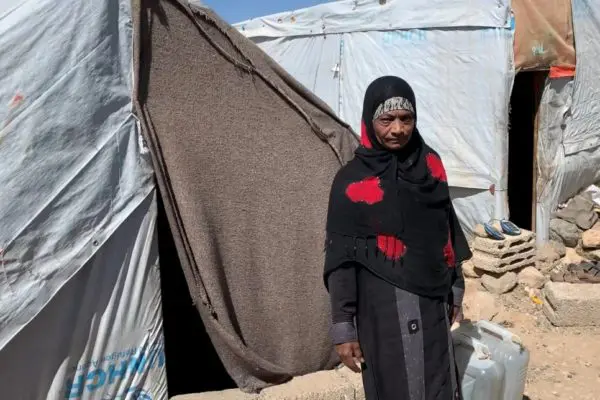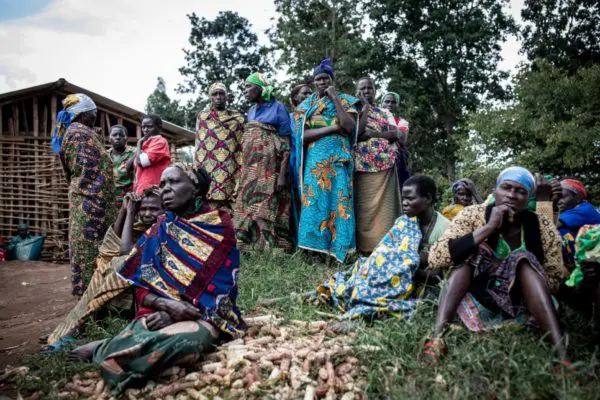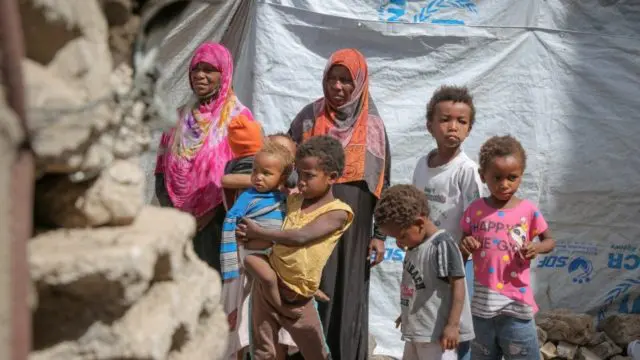
Nabiha, a displaced woman in Hudaydah, Yemen, tends to a patient. © UNHCR/Assma Mohamed Alsaghir
As the world’s worst humanitarian crisis rages on, women and children make up three-quarters of the four million people forced from their homes, putting them at greater risk.
By Jean-Nicolas Beuze in Hudaydah, Yemen
On a small patch of land on the outskirts of Hudaydah, Yemen’s main Red Sea port, 38-year-old Nabiha is attempting to rebuild her life brick by brick. Widowed in the early days of the country’s conflict and displaced multiple times by fighting, the mother-of-three is constructing a home she hopes will restore the stability her family has lost.
Originally from Al-Mokha, a city 185 kilometres down the coast famous for its historic coffee trade, Nabiha fled to Hudaydah with her mother, brother, daughter and two sons in 2015, after her husband was killed in an explosion while at work.
“He was rushed to the hospital, but after a week-long battle between life and death, he died,” Nabiha said. “It was a very bad and difficult time for us. I decided to leave. I was worried that my children would die too … if we stayed there.”
After spending most of her savings renting accommodation in Hudaydah, Nabiha again found herself caught up in intense fighting that erupted in the city at the end of 2017. The violence has killed more than 2,900 civilians and damaged more than 6,600 homes, 33 schools and 43 roads and bridges, making Hudaydah one of the worst affected cities in Yemen by six years of conflict.
“Families were killed and injured all around us.”
Without the means to leave and start over again elsewhere, Nabiha had no choice but to stay in the city, moving the family from place to place as the frontlines shifted.
“I was living very close to the fighting. I had to move to another area because families were killed and injured all around us. We moved three times from one neighborhood to another to avoid bullets and airstrikes.” Nabiha said.
As Yemen’s conflict enters its seventh year this month, Nabiha’s desperate struggles have become a familiar experience for millions caught up in the world’s worst humanitarian crisis.
Since 2015, more than 20,000 civilian deaths and injuries have been recorded and more than 4 million people have been forced to flee within the country’s borders. Three-quarters of internally displaced Yemenis are women and children, while one-in-four displaced families are headed by women like Nabiha.
In a patriarchal society like Yemen, where socio-cultural norms and practices shape the lives of women, the conflict has increased the risk of exploitation and abuse.
To try to support her family, Nabiha occasionally works as a housekeeper and uses the basic nursing skills she learned from her late husband – who was a nurse at a private hospital in Al-Mokha – working shifts at local private health clinics and giving patients injections, basic first aid and taking their blood pressure.
As well as earning her between 250-500 Yemeni Rials (US$2-4) per day, word of her skills also spread quickly among her neighbours, who come to her for help and refer to her affectionately as “doctor”. In a country facing a severe shortage of trained medical personnel and where only half of health facilities are still operational, the few skills Nabiha has go a long way.
The little money she is able to earn is often insufficient to cover the family’s basic needs. Their diet consists almost entirely of rice and beans, and frequently they only have enough for one proper meal a day, with Nabiha sometimes skipping even these so her children have more to eat.
Such coping strategies have become common as Yemen’s hunger crisis deepens. Displaced families are four times more likely than other Yemenis to suffer from food insecurity, and according to assessments some 2.6 million displaced people in the country are just a step away from famine.
Nabiha has also received cash assistance from UNHCR, the UN Refugee Agency, as part of its efforts to assist and protect the most vulnerable forcibly displaced families inside the country.
Over the past two years, as people’s needs have increased, UNHCR’s cash assistance programme in the country has grown to become one of the five largest in the world, helping more than a million people annually. Such assistance is even more essential for the two thirds of displaced Yemeni families that, unlike Nabiha’s, have no form of income.
“I want a better life for them.”
It was thanks to the assistance she received, as well as securing a loan and using the last of her savings, that Nabiha was able to buy the land where she is now in the process of building a more permanent home for her family, far from the areas of continued fighting.
“It’s away from the city and close to a garbage dump, but it’s better than renting,” Nabiha said. “Before that, I used to pay rent and sometimes I didn’t have enough money to pay, and the landlord would threaten [to evict] me. Back then, I couldn’t sleep because I was thinking of how to manage the money for rent.”
For now, the basic brick structure consists of only one room with a temporary roof which leaks when it rains. But in spite of their continuing hardships and the challenge of building a home on a shoestring, Nabiha hopes to provide her children with a proper education and with it the chance to achieve their dreams.
“My daughter wants to be a pharmacist … one of my boys wants to be a doctor and the second one wants to work in media,” Nabiha said. “I want my children to be independent. They are excellent in their studies. I want them to rely on themselves when I die. I want a better life for them; better than mine.”





